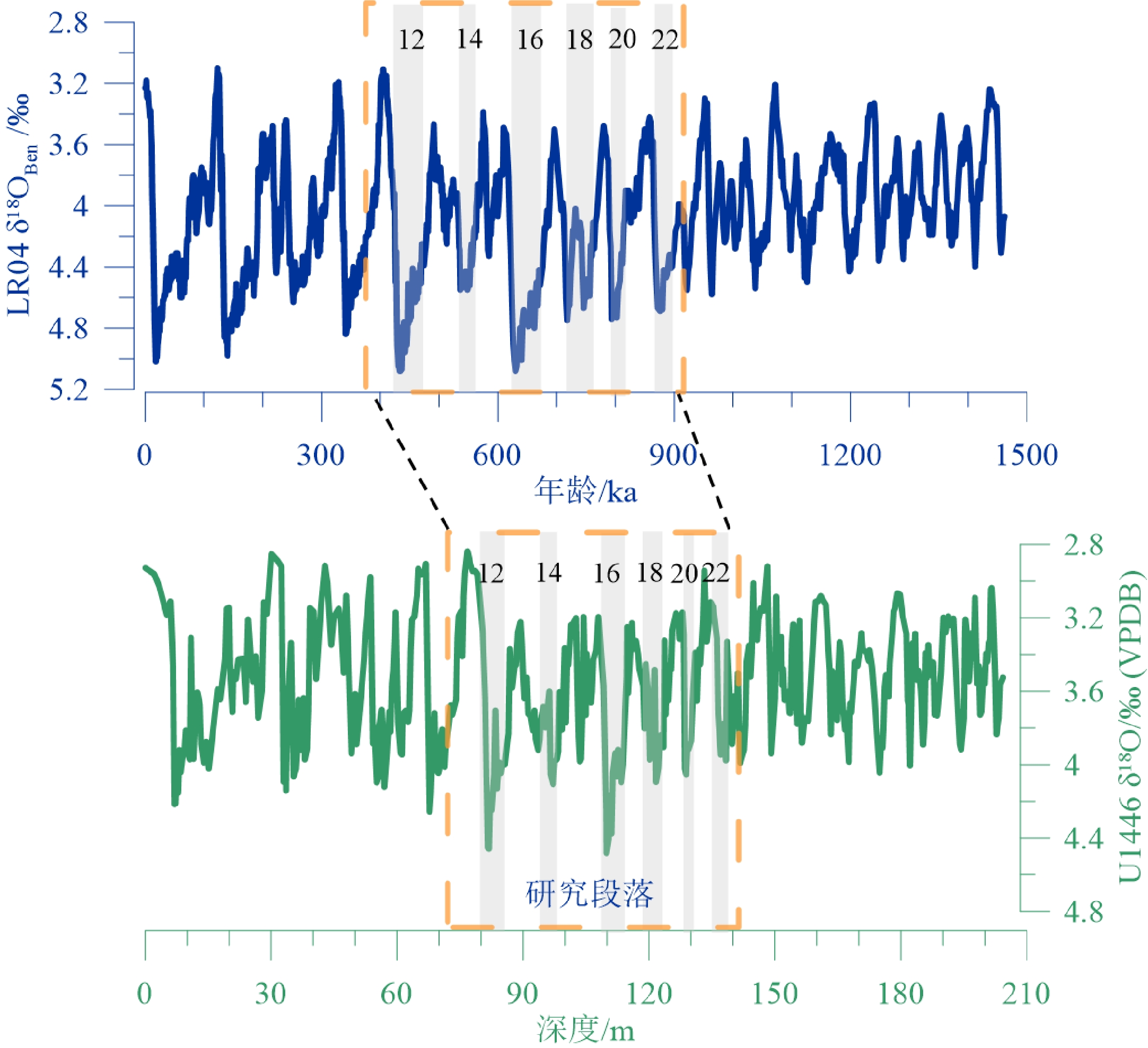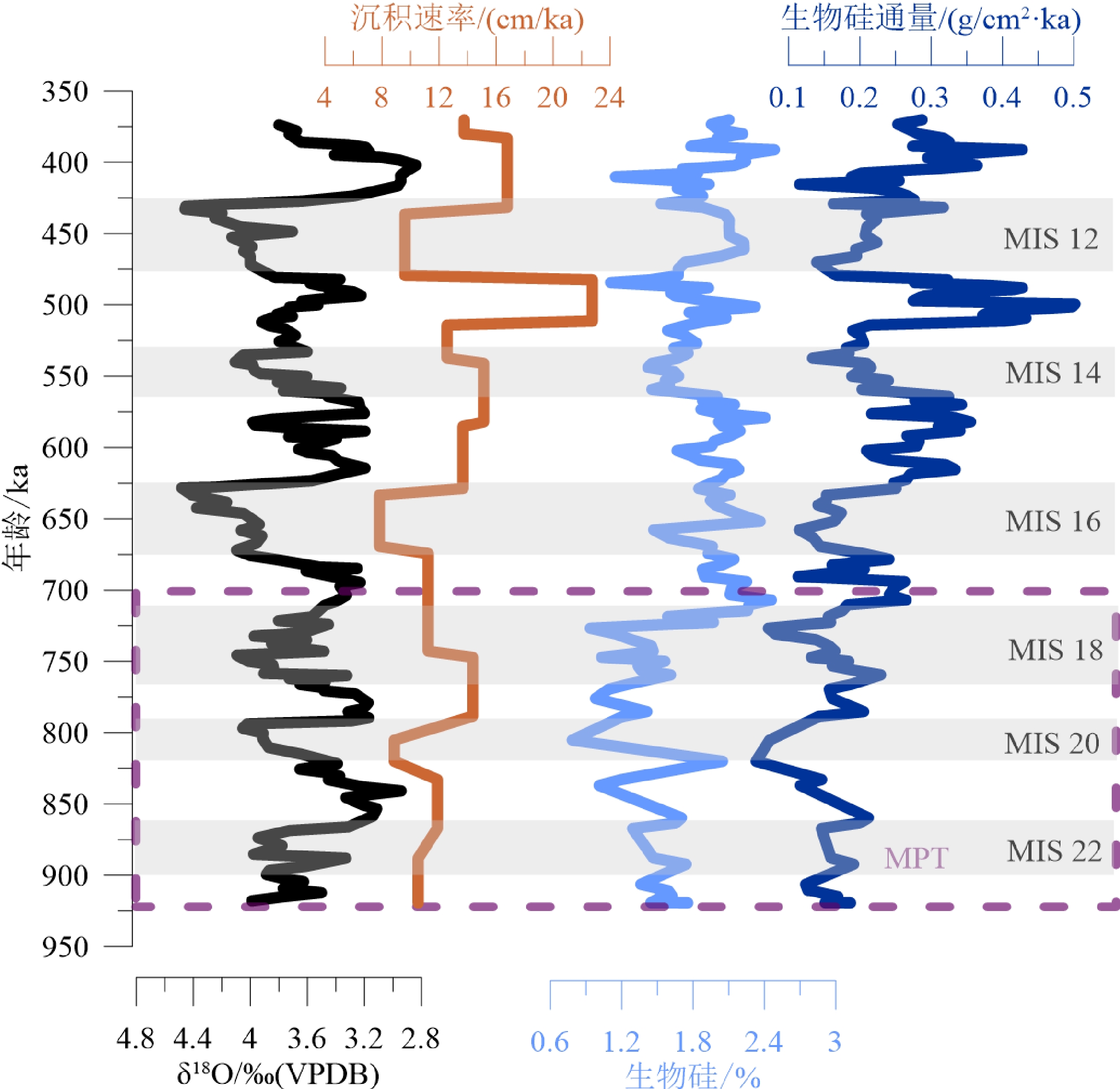Changes in siliceous paleoproductivity during the early Middle Pleistocene in the Northwest Bay of Bengal
-
摘要:
西北孟加拉湾位于印度夏季风的核心降水区,是研究印度季风活动及其对环境影响的理想地区。通过对西北孟加拉湾马哈纳迪盆地IODP353航次U1446站位岩芯生物硅含量和沉积通量的分析,重建了研究区早更新世末—中更新世早期(920~370 ka)的硅质生物生产力演变历史,探讨了印度夏季风降水和径流活动对研究区古生产力变化的影响机制。结果显示,西北孟加拉湾在920~370 ka期间,硅质生产力总体上表现为中更新世过渡期(Mid-Pleistocene Transition,MPT)较低,MPT之后呈上升的趋势;具有明显的冰期-间冰期旋回性,冰期时下降,间冰期上升,且在MPT之后波动幅度增大。对比该站位已有的δ18Osw和Rb/Ca比值等夏季风降水和径流指标发现,印度夏季风增强时硅质生产力上升,减弱时硅质生产力下降,推测印度夏季风的增强导致孟加拉湾降水以及周边河流径流量剧增,河流提供的营养物质使得西北孟加拉湾表层硅质生物勃发,硅质生产力迅速升高。而印度夏季风减弱时,营养盐的减少抑制了表层浮游硅质生物的繁殖,从而使得硅质生产力下降。U1446站位生物硅通量的频谱和小波分析也显示,研究区的硅质生产力受轨道周期变化的调控。
Abstract:The Northwest Bay of Bengal (BoB) is located in the core precipitation zone of the Indian Summer Monsoon (ISM), and an ideal area to study Indian monsoon activity and its impact on the environment. We reconstructed the history of siliceous productivity evolution in the study area during late Early Pleistocene to early Middle Pleistocene (920~370 ka) by analyzing biogenic silica content and sediment fluxes of cores from Site U1446 of IODP Expedition 353 in the Mahanadi Basin, Northwest BoB, and explored the mechanism of ISM precipitation and runoff activities on the paleoproductivity changes in the study area. Results indicate that siliceous productivity reflects a trend from low in the Mid-Pleistocene Transition (MPT) to high after MPT in the northwest BoB during 920~370 ka in an obvious glacial-interglacial cycle. It decreased during the glacial period and increased during the interglacial period, and the fluctuation increased after the MPT. A comparison of existing summer monsoon precipitation and runoff indicators such as δ18Osw and Rb/Ca ratio at this site reveals that siliceous productivity increased (decreased) when the ISM strengthened (weakened). It is hypothesized that the enhanced ISM led to a dramatic increase in runoff from the Indian peninsula and precipitation in the BoB, and the nutrients from rivers led to a proliferation of surface siliceous organisms and a rapid upsurge in siliceous productivity in the northwest BoB. However, the weakened ISM and the reduction of nutrients inhibited the flourishing of planktonic siliceous organisms, which then decreased the surface productivity. Spectral and wavelet analyses of biogenic silica fluxes at Site U1446 also indicate that siliceous productivity was modulated by orbital cycle variations in this study area.
-

-
[1] 汪品先, 翦知湣, 赵泉鸿, 等. 南海演变与季风历史的深海证据[J]. 科学通报, 2003, 48(23):2549-2561 doi: 10.1360/03wd0156
WANG Pinxian, JIAN Zhimin, ZHAO Quanhong, et al. Evolution of the South China Sea and monsoon history revealed in deep-sea records [J]. Chinese Science Bulletin, 2003, 48(23): 2549-2561. doi: 10.1360/03wd0156
[2] Felix M. A comparison of equations commonly used to calculate organic carbon content and marine palaeoproductivity from sediment data [J]. Marine Geology, 2014, 347: 1-11. doi: 10.1016/j.margeo.2013.10.006
[3] Xu Y H, Wang L, Lai Z K, et al. The biogenic silica variation and paleoproductivity evolution in the eastern Indian Ocean during the past 20 0000 a [J]. Acta Oceanologica Sinica, 2019, 38(1): 78-84. doi: 10.1007/s13131-019-1372-z
[4] Nelson D M, Tréguer P, Brzezinski M A, et al. Production and dissolution of biogenic silica in the ocean: revised global estimates, comparison with regional data and relationship to biogenic sedimentation [J]. Global Biogeochemical Cycles, 1995, 9(3): 359-372. doi: 10.1029/95GB01070
[5] Madhupratap M, Gauns M, Ramaiah N, et al. Biogeochemistry of the Bay of Bengal: physical, chemical and primary productivity characteristics of the central and western Bay of Bengal during summer monsoon 2001 [J]. Deep Sea Research Part II:Topical Studies in Oceanography, 2003, 50(5): 881-896. doi: 10.1016/S0967-0645(02)00611-2
[6] Cortese G, Gersonde R, Hillenbrand C D, et al. Opal sedimentation shifts in the World Ocean over the last 15 Myr [J]. Earth and Planetary Science Letters, 2004, 224(3-4): 509-527. doi: 10.1016/j.jpgl.2004.05.035
[7] Volk T, Hoffert M I. Ocean carbon pumps: analysis of relative strengths and efficiencies in ocean-driven atmospheric CO2 changes[M]//Sundquist E T, Broecker W S. The Carbon Cycle and Atmospheric CO2: Natural Variations Archean to Present. Washington: American Geophysical Union, 1985: 99-110.
[8] Prasanna Kumar S, Nuncio M, Ramaiah N, et al. Eddy-mediated biological productivity in the Bay of Bengal during fall and spring intermonsoons [J]. Deep Sea Research Part I:Oceanographic Research Papers, 2007, 54(9): 1619-1640. doi: 10.1016/j.dsr.2007.06.002
[9] Phillips S C, Johnson J E, Giosan L, et al. Monsoon-influenced variation in productivity and lithogenic sediment flux since 110 ka in the offshore Mahanadi Basin, northern Bay of Bengal [J]. Marine and Petroleum Geology, 2014, 58: 502-525. doi: 10.1016/j.marpetgeo.2014.05.007
[10] Prasanna Kumar S, Muraleedharan P M, Prasad T G, et al. Why is the Bay of Bengal less productive during summer monsoon compared to the Arabian Sea? [J]. Geophysical Research Letters, 2002, 29(24): 2235.
[11] Lee J, Kim S, Khim B K. A paleoproductivity shift in the northwestern Bay of Bengal (IODP Site U1445) across the Mid-Pleistocene transition in response to weakening of the Indian summer monsoon [J]. Palaeogeography, Palaeoclimatology, Palaeoecology, 2020, 560: 110018. doi: 10.1016/j.palaeo.2020.110018
[12] Ota Y, Kuroda J, Yamaguchi A, et al. Monsoon-influenced variations in plankton community structure and upper-water column stratification in the western Bay of Bengal during the past 80 ky [J]. Palaeogeography, Palaeoclimatology, Palaeoecology, 2019, 521: 138-150. doi: 10.1016/j.palaeo.2019.02.020
[13] Clark P U, Archer D, Pollard D, et al. The middle Pleistocene transition: characteristics, mechanisms, and implications for long-term changes in atmospheric pCO2 [J]. Quaternary Science Reviews, 2006, 25(23-24): 3150-3184. doi: 10.1016/j.quascirev.2006.07.008
[14] LaFond E C. Bay of Bengal[M]//Fairbridge R W. The Encyclopedia of Oceanography. New York: Van Nostrand Reinhold Co. , 1966: 110-118.
[15] Curray J R, Emmel F J, Moore D G, et al. Structure, tectonics, and geological history of the northeastern Indian ocean[M]//Nairn A E M, Stehli F G. The Ocean Basins and Margins: The Indian Ocean. New York: Springer, 1982: 399-450.
[16] Subrahmanyam V, Subrahmanyam A S, Murty G P S, et al. Morphology and tectonics of Mahanadi Basin, northeastern continental margin of India from geophysical studies [J]. Marine Geology, 2008, 253(1-2): 63-72. doi: 10.1016/j.margeo.2008.04.007
[17] Chatterjee A, Shankar D, Shenoi S S C, et al. A new atlas of temperature and salinity for the North Indian Ocean [J]. Journal of Earth System Science, 2012, 121(3): 559-593. doi: 10.1007/s12040-012-0191-9
[18] Boyer T P, Antonov J I, Baranova O K, et al. World ocean database 2013[R]. Silver Spring: National Oceanographic Data Center Ocean Climate Laboratory, 2013.
[19] Da Silva R, Mazumdar A, Mapder T, et al. Salinity stratification controlled productivity variation over 300 ky in the Bay of Bengal [J]. Scientific Reports, 2017, 7(1): 14439. doi: 10.1038/s41598-017-14781-3
[20] Varkey M J, Murty V S N, Suryanarayana A. Physical oceanography of the bay of Bengal and Andaman sea [J]. Oceanography and Marine Biology:An Annual Review, 1996, 34: 1-70.
[21] Miranda J, Baliarsingh S K, Lotliker A A, et al. Long-term trend and environmental determinants of phytoplankton biomass in coastal waters of northwestern Bay of Bengal [J]. Environmental Monitoring and Assessment, 2020, 192(1): 55. doi: 10.1007/s10661-019-8033-8
[22] Shankar D, McCreary J P, Han W, et al. Dynamics of the East India Coastal Current: 1. Analytic solutions forced by interior Ekman pumping and local alongshore winds [J]. Journal of Geophysical Research:Oceans, 1996, 101(C6): 13975-13991. doi: 10.1029/96JC00559
[23] Shetye S R, Shenoi S S C, Gouveia A D, et al. Wind-driven coastal upwelling along the western boundary of the Bay of Bengal during the southwest monsoon [J]. Continental Shelf Research, 1991, 11(11): 1397-1408. doi: 10.1016/0278-4343(91)90042-5
[24] Clemens S C, Kuhnt W, LeVay L J, et al. Indian monsoon rainfall[C]//Proceedings of the International Ocean Discovery Program. College Station, TX: International Ocean Discovery Program, 2016: 1-15.
[25] Mortlock R A, Froelich P N. A simple method for the rapid determination of biogenic opal in pelagic marine sediments [J]. Deep Sea Research Part A. Oceanographic Research Papers, 1989, 36(9): 1415-1426. doi: 10.1016/0198-0149(89)90092-7
[26] Wang D, Ding X, Bassinot F. Observations of contrasted glacial-interglacial dissolution of foraminifera above the lysocline in the Bay of Bengal, northeastern Indian Ocean [J]. Acta Oceanologica Sinica, 2021, 40(1): 155-161. doi: 10.1007/s13131-021-1821-3
[27] Clemens S C, Yamamoto M, Thirumalai K, et al. Remote and local drivers of Pleistocene South Asian summer monsoon precipitation: a test for future predictions [J]. Science Advances, 2021, 7(23): eabg3848. doi: 10.1126/sciadv.abg3848
[28] Lisiecki L E, Raymo M E. A pliocene-pleistocene stack of 57 globally distributed benthic δ18O records [J]. Paleoceanography, 2005, 20(1): PA1003.
[29] 王汝建, 肖文申, 向霏, 等. 北冰洋西部表层沉积物中生源组分及其古海洋学意义[J]. 海洋地质与第四纪地质, 2007, 27(6):61-69
WANG Rujian, XIAO Wenshen, XIANG Fei, et al. Distribution pattern of biogenic components in surface sediments of the western arctic ocean and their paleoceanographic implications [J]. Marine Geology & Quaternary Geology, 2007, 27(6): 61-69.
[30] Berger W H. Biogenous deep sea sediments: production, preservation and interpretation[M]//Riley J P, Chester R. Treatise on Chemical Oceanography 5. San Diego, California: Academic, 1976: 265-388.
[31] Ragueneau O, Tréguer P, Leynaert A, et al. A review of the Si cycle in the modern ocean: recent progress and missing gaps in the application of biogenic opal as a paleoproductivity proxy [J]. Global and Planetary Change, 2000, 26(4): 317-365. doi: 10.1016/S0921-8181(00)00052-7
[32] 同济大学海洋地质系. 古海洋学概论[M]. 上海: 同济大学出版社, 1989: 1-316
Department of Marine Geology, Tongji University. Introduction to Paleoceanography[M]. Shanghai: Tongji University Press, 1989: 1-316.
[33] Liu S F, Zhang H, Cao P, et al. Paleoproductivity evolution in the northeastern Indian Ocean since the last glacial maximum: evidence from biogenic silica variations [J]. Deep Sea Research Part I:Oceanographic Research Papers, 2021, 175: 103591. doi: 10.1016/j.dsr.2021.103591
[34] Achyuthan H, Deshpande R D, Rao M S, et al. Stable isotopes and salinity in the surface waters of the Bay of Bengal: implications for water dynamics and palaeoclimate [J]. Marine Chemistry, 2013, 149: 51-62. doi: 10.1016/j.marchem.2012.12.006
[35] Paul J T, Ramaiah N, Sardessai S. Nutrient regimes and their effect on distribution of phytoplankton in the Bay of Bengal [J]. Marine Environmental Research, 2008, 66(3): 337-344. doi: 10.1016/j.marenvres.2008.05.007
[36] Chakrapani G J, Subramanian V. Factors controlling sediment discharge in the Mahanadi River basin, India [J]. Journal of Hydrology, 1990, 117(1-4): 169-185. doi: 10.1016/0022-1694(90)90091-B
[37] Georg R B, West A J, Basu A R, et al. Silicon fluxes and isotope composition of direct groundwater discharge into the Bay of Bengal and the effect on the global ocean silicon isotope budget [J]. Earth and Planetary Science Letters, 2009, 283(1-4): 67-74. doi: 10.1016/j.jpgl.2009.03.041
[38] Laruelle G G, Roubeix V, Sferratore A, et al. Anthropogenic perturbations of the silicon cycle at the global scale: key role of the land–ocean transition [J]. Global Biogeochemical Cycles, 2009, 23(4): GB4031.
[39] Datta D K, Gupta L P, Subramanian V. Distribution of C, N and P in the sediments of the Ganges-Brahmaputra-Meghna river system in the Bengal basin [J]. Organic Geochemistry, 1999, 30(1): 75-82. doi: 10.1016/S0146-6380(98)00203-4
[40] Sarma V V S S, Rao G D, Viswanadham R, et al. Effects of freshwater stratification on nutrients, dissolved oxygen, and phytoplankton in the Bay of Bengal [J]. Oceanography, 2016, 29(2): 222-231. doi: 10.5670/oceanog.2016.54
[41] Short D A, Mengel J G, Crowley T J, et al. Filtering of milankovitch cycles by earth's geography [J]. Quaternary Research, 1991, 35(2): 157-173. doi: 10.1016/0033-5894(91)90064-C
[42] Wang P X, Tian J, Lourens L J. Obscuring of long eccentricity cyclicity in Pleistocene oceanic carbon isotope records [J]. Earth and Planetary Science Letters, 2010, 290(3-4): 319-330. doi: 10.1016/j.jpgl.2009.12.028
[43] Araya-Melo P A, Crucifix M, Bounceur N. Global sensitivity analysis of the Indian monsoon during the Pleistocene [J]. Climate of the Past, 2015, 11(1): 45-61. doi: 10.5194/cp-11-45-2015
[44] Erb M P, Jackson C S, Broccoli A J. Using single-forcing GCM simulations to reconstruct and interpret Quaternary climate change [J]. Journal of Climate, 2015, 28(24): 9746-9767. doi: 10.1175/JCLI-D-15-0329.1
[45] Kim S, Takahashi K, Khim B K, et al. Biogenic opal production changes during the Mid-Pleistocene Transition in the Bering Sea (IODP Expedition 323 Site U1343) [J]. Quaternary Research, 2014, 81(1): 151-157. doi: 10.1016/j.yqres.2013.10.001
[46] Iwasaki S, Takahashi K, Kanematsu Y, et al. Paleoproductivity and paleoceanography of the last 4.3 Myrs at IODP Expedition 323 Site U1341 in the Bering Sea based on biogenic opal content [J]. Deep Sea Research Part II:Topical Studies in Oceanography, 2016, 125-126: 145-154. doi: 10.1016/j.dsr2.2015.04.005
[47] Berger A. Orbital variations and insolation database[R]. Boulder CO, USA: National Oceanic and Atmospheric Administration, 1992.
-




 下载:
下载:






